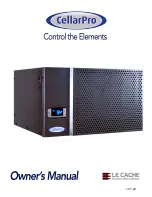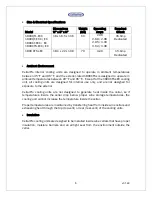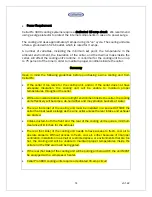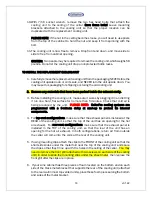
13
v3.1.22
With our duct option, the hot side of our units can be ducted up to 50 equivalent feet
per duct. When calculating equivalent feet, each 90 degree turn in the ducting
approximately equals 8’ of ducting. Be sure to use gradual turns to avoid restricting
airflow inside the ducting. Consult your HVAC professional for further information.
IF THE COOLING UNIT WILL BE LOCATED ENTIRELY INSIDE THE CELLAR:
The HOT side airflows (both exhaust AND intake) MUST be vented to space
outside the cellar with insulated ducting (R-6 minimum)
The rear duct hood must be wrapped with insulation to minimize heat gain
inside the cellar
The openings at the bottom of the rear duct hood must be sealed to prevent air
exchange inside the cellar
The COLD sides (ie Front) of 1800 cooling units cannot be ducted unless they are
located directly above the cellar. In this scenario, our front intake hood is required, and
2 openings will be required in the ceiling – one for the cold-air discharge, and one for
the return air from the cellar.
INSIDE THE CELLAR
CellarPro cooling units are designed to turn on when the temperature near the ceiling
inside the cellar exceeds the Minimum Set Point plus the Temperature Differential,
and turn off when the temperature inside the cellar drops below the Minimum Set
Point. The Minimum Set Point and Temperature Differential can be set according to
instructions in the following Chapter. For example, if the Minimum Set Point is 58°F
and the Temperature Differential is 4°F, the cooling unit will turn on when the
temperature inside the cellar rises above 62°F, and turn off when the temperature
falls below 58°F. In this example, the cellar temperature will average 60°F.
At least 8” of the front of the cooling unit must protrude inside the cellar – in other
words, the front of the cooling unit cannot be buried inside the wall.
1. Evaporator Air Intake. The evaporator coils are located on the face of the cooling
unit behind the grill. CellarPro cooling units are designed to be mounted at the highest
point inside wine cellars, so that warm air – which rises – will be the first to pass over
the evaporator coils, which will remove the heat from the air. To ensure proper airflow,
a minimum of 3” of clearance is required in front of the cooling unit.
2. Evaporator Air Exhaust. Cold air is exhausted through the bottom of the cooling unit.
Because CellarPro cooling units are located at the highest point inside wine cellars,
the cold air will fall to the bottom of the cellar. To ensure proper airflow and reduce
temperature stratification inside the cellar, the space below the cold air discharge
should be clear of any obstructions, including wine bottles, wine racks, etc.















































